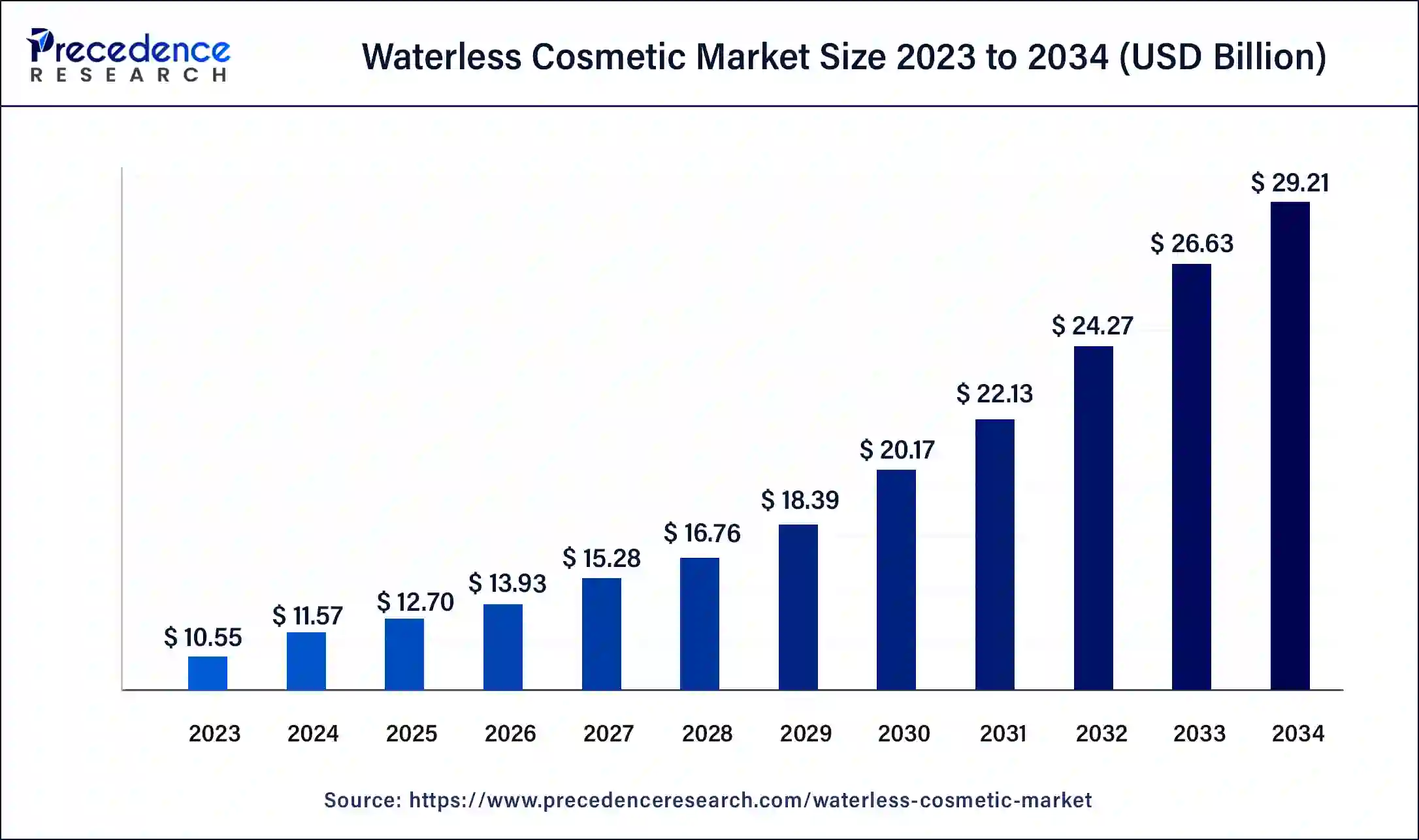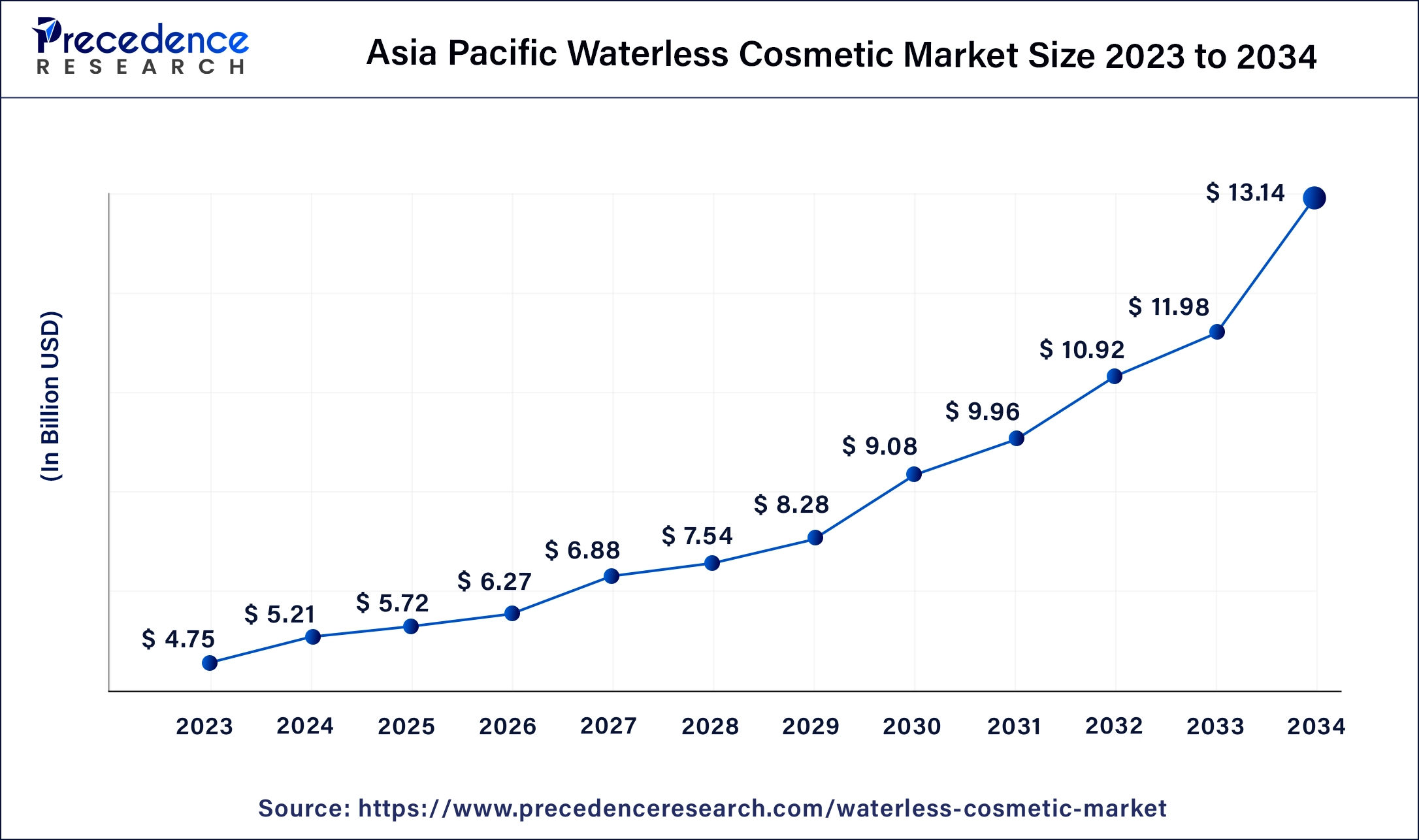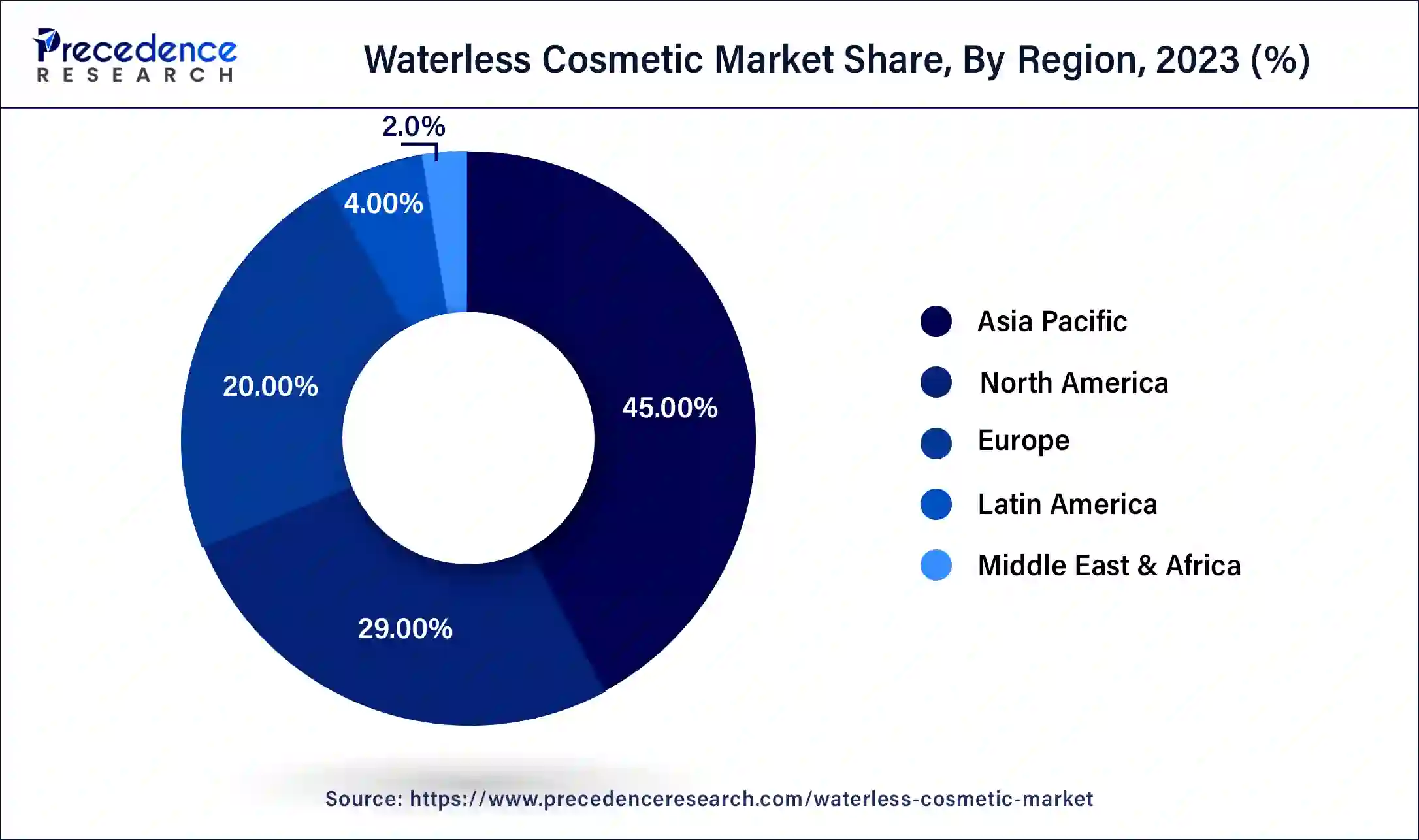List of Contents
Waterless Cosmetic Market Size and Forecast 2025 to 2034
The global waterless cosmetic market size accounted for USD 11.57 billion in 2024 and is expected to be worth around USD 29.21 billion by 2034, at a CAGR of 9.7% from 2025 to 2034.

Waterless Cosmetic Market Key Takeaways
- Asia-Pacific contributed more than 45% of revenue share in 2024.
- The North America is estimated to expand the fastest CAGR between 2025 and 2034.
- By product, the skincare segment has held the largest market share of 32% in 2024.
- By product, the makeup segment is anticipated to grow at a remarkable CAGR of 10.3% between 2025 and 2034.
- By gender, the women segment generated over 78% of revenue share in 2023.
- By gender, the men segment is expected to expand at the fastest CAGR over the projected period.
- By nature, the synthetic segment has held the largest market share of 75% in 2024.
- By nature, the organic segment is expected to expand at the fastest CAGR over the projected period.
- By distribution channel, the supermarkets and hypermarkets segment generated over 41% of revenue share in 2024.
- By distribution channel, the e-commerce segment is expected to expand at the fastest CAGR over the projected period.
Asia Pacific Waterless Cosmetic Market Size and Growth 2025 to 2034
The Asia Pacific waterless cosmetic market size was estimated at USD 5.21 billion in 2024 and is predicted to be worth around USD 13.14 billion by 2034, at a CAGR of 9.9% from 2025 to 2034.

Asia-Pacific held the largest revenue share of 45% in 2024. Asia-Pacific dominates the waterless cosmetic market due to a confluence of factors. The region's robust economic growth, burgeoning population, and increasing disposable income drive the demand for innovative beauty products. Additionally, rising awareness of environmental issues aligns with the market's emphasis on sustainability. The diverse consumer base, coupled with a growing preference for natural and eco-friendly products, positions Asia-Pacific as a key market for waterless cosmetics. As the region embraces modern beauty trends, the waterless cosmetic market experiences substantial growth and market share in this dynamic and evolving market landscape.
The rapid change in climatic conditions in Asia Pacific significantly increases the need for effective sun care and skin and planet-friendly cosmetic products among eco-conscious customers. The market has witnessed the increasing demand for skin care products from both men and women in the region. As they are widely adopting an eco-friendly lifestyle with increasing awareness of sustainable cosmetics, they mostly prefer waterless cosmetics products that are rich in anti-aging and beautifying agents.

North America is estimated to observe the fastest expansion. North America holds a major growth in the waterless cosmetic market due to a combination of factors. The region's consumers exhibit a strong preference for sustainable and eco-friendly beauty products, aligning with the core principles of waterless cosmetics. Additionally, robust e-commerce infrastructure, widespread awareness of environmental issues, and a thriving beauty industry contribute to the market's growth. The presence of innovative cosmetic brands, coupled with the high purchasing power of North American consumers, further solidifies the region's dominant position in the waterless cosmetic market.
The rising initiative taken by the key market players to spread awareness regarding the significance of waterless beauty is anticipated to propel the regional growth in the coming years. For instance, in February 2025, OLIVE TREE PEOPLE, a pioneer in waterless beauty, launched a 2025 educational campaign that is designed to educate US consumers on waterless beauty and its vital role in redefining modern skincare. The collaboration brought together a team of 15, including designers and artists. The campaign images were designed to give a message that beauty can be both eco-friendly and bold.
Market Overview
Waterless cosmetics represent an innovative shift in the beauty sector, with a primary goal of reducing water consumption and lessening environmental impact. Unlike traditional cosmetics that often incorporate a substantial amount of water, contributing to a larger carbon footprint through production, transportation, and packaging, waterless cosmetics take a different approach. They are crafted without water as a primary ingredient, utilizing alternative bases like oils, butters, and botanical extracts.
This approach not only addresses sustainability concerns but also results in more concentrated and potent products. Waterless cosmetics can take various forms, including powders, balms, and solid formulations, offering consumers a diverse range of choices. As the beauty industry continues to embrace eco-friendly practices, waterless cosmetics play a crucial role in promoting environmental sustainability while providing consumers with effective and innovative beauty solutions.
Every year, nearly 120 billion units of cosmetics and toiletries are packaged and shipped around the world. This results in the industry generating a huge carbon footprint. To combat this increases, the adoption of waterless cosmetics has become popular among eco-conscious customers.
Waterless Cosmetic Market Growth Factors
- Environmental awareness: Increasing consumer concern about environmental impact drives the demand for waterless cosmetics, as they contribute to sustainability by reducing water consumption.
- Reduced carbon footprint: Waterless cosmetics minimize the carbon footprint associated with production, transportation, and packaging, aligning with eco-friendly trends in the beauty industry.
- Concentrated formulations: Waterless products often boast concentrated formulations, offering consumers more potent and effective skincare and beauty solutions.
- Longer shelf life: The absence of water in formulations can contribute to extended product shelf life, reducing waste and promoting sustainability.
- Innovative formulations: Companies are investing in research and development to create innovative waterless formulations, leading to unique and advanced cosmetic products.
- Consumer demand for variety: Waterless cosmetics come in various forms such as powders, balms, and solid formulations, meeting consumer demands for diverse and customizable beauty options.
- Natural ingredients: Waterless formulations often prioritize natural ingredients like oils and botanical extracts, appealing to consumers seeking clean and green beauty alternatives.
- Travel-friendly products: The concentrated nature of waterless cosmetics makes them ideal for travel, catering to the needs of on-the-go consumers.
- Reduced packaging waste: With less reliance on water, waterless cosmetics contribute to reduced packaging waste, aligning with the global movement towards sustainable packaging solutions.
- Marketing emphasis on sustainability: Brands are leveraging waterless formulations as a key marketing point, appealing to environmentally conscious consumers and enhancing brand image.
- Innovative application methods: Waterless cosmetics encourage innovative application methods, fostering creativity and uniqueness in the beauty routine.
- Cost-effective manufacturing: The production of waterless cosmetics can be cost-effective due to the reduced need for water and simpler manufacturing processes.
- Educational initiatives: Brands are investing in consumer education to raise awareness about the benefits of waterless cosmetics, driving market growth through informed purchasing decisions.
- Collaborations and partnerships: Collaborations between cosmetic brands and environmental organizations further promote waterless beauty products, amplifying their market presence.
- Regulatory support: Governments and regulatory bodies are increasingly supporting sustainable practices, creating a conducive environment for the growth of waterless cosmetic markets.
- Emerging markets embrace sustainability: Growing economies are witnessing an increased adoption of sustainability practices, boosting the demand for waterless cosmetics in emerging markets.
- Technological advancements: Ongoing advancements in cosmetic technology contribute to the development of more sophisticated and effective waterless formulations.
- Social media influence: Beauty influencers and social media play a significant role in promoting waterless cosmetics, driving trends and shaping consumer preferences.
- Corporate social responsibility: Larger cosmetic companies are integrating waterless products into their CSR initiatives, aligning with broader sustainability goals and contributing to market growth.
Market Scope
| Report Coverage | Details |
| Growth Rate from 2025 to 2034 | CAGR of 9.7% |
| Market Size in 2024 | USD 11.57 Billion |
| Market Size in 2025 | USD 12.70 billion |
| Market Size by 2034 | USD 29.21 Billion |
| Largest Market | Asia Pacific |
| Base Year | 2024 |
| Forecast Period | 2025 to 2034 |
| Segments Covered | By Product, By Gender, By Nature, and By Distribution Channel |
| Regions Covered | North America, Europe, Asia-Pacific, Latin America, and Middle East & Africa |
Market Dynamics
Driver
Travel-friendly products and packaging innovation
Travel-friendly products and innovative packaging solutions significantly boost the demand for the waterless cosmetic market. The compact and lightweight nature of waterless cosmetics makes them ideal for on-the-go consumers, aligning with the growing trend of travel-friendly beauty products. Consumers increasingly prioritize convenience, and waterless cosmetics cater to this need by offering easy-to-carry formulations, including powders, solid products, and compact balms.
Moreover, the surge in market demand is further propelled by packaging innovations that accompany waterless cosmetics. Sustainable and eco-friendly packaging options contribute to the overall appeal of waterless products, resonating with environmentally conscious consumers. Reduced packaging waste and the use of materials that align with sustainable practices enhance the market's attractiveness. As the beauty industry continues to emphasize both convenience and sustainability, the combination of travel-friendly features and packaging innovation establishes waterless cosmetics as a preferred choice for modern, eco-conscious consumers.
Restraint
Perceived lack of hydration and limited product range
The perceived lack of hydration and a limited product range pose significant restraints on the market demand for waterless cosmetics. Consumers, accustomed to traditional water-based formulations, may hesitate to embrace waterless alternatives due to concerns about potential dryness. The misconception that waterless cosmetics lack the ability to provide sufficient hydration creates a barrier, hindering widespread adoption. Brands need to invest in clear communication and education to dispel these concerns, emphasizing the hydrating properties of alternative ingredients used in waterless formulations.
Additionally, the limited product range within the waterless cosmetic market impacts consumer choice and adoption. While the variety of waterless products is expanding, there is still a gap in the availability of diverse options, limiting choices for consumers with specific beauty preferences. This restriction can impede the market's growth as consumers may revert to traditional cosmetics that offer a broader range of formulations until waterless alternatives can provide a comparable selection. Overcoming these restraints requires continuous innovation in formulations and a strategic approach to addressing consumer perceptions through targeted marketing and education campaigns.
Opportunity
Rising eco-conscious consumerism and innovation in formulations
Rising eco-conscious consumerism is a key driver of opportunities in the waterless cosmetic market. As consumers increasingly prioritize sustainable choices, waterless cosmetics align with their values by minimizing environmental impact. Brands that emphasize eco-friendly practices and communicate the positive environmental footprint of waterless formulations can tap into this growing market segment, fostering brand loyalty and attracting environmentally conscious consumers. Simultaneously, innovation in formulations presents a significant opportunity for the waterless cosmetic market.
Ongoing research and development efforts enable brands to create innovative, high-performance products that meet consumer demands for effective and sustainable beauty solutions. By incorporating cutting-edge ingredients, advanced technologies, and addressing specific skincare needs, waterless cosmetics can differentiate themselves in a competitive market, appealing to consumers seeking both efficacy and eco-consciousness. Embracing these opportunities positions waterless cosmetic brands at the forefront of the beauty industry's evolution toward sustainability and innovation.
Product Insights
In 2024, the skincare segment had the highest market share of 32% on the basis of the product. The skincare segment in the waterless cosmetic market encompasses products formulated without water, emphasizing concentrated and nourishing ingredients. This category includes waterless cleansers, moisturizers, serums, and masks. A notable trend is the integration of natural oils, botanical extracts, and innovative solid formulations, offering consumers effective hydration and skincare benefits without the environmental impact of traditional water-based products. The waterless skincare segment aligns with the broader industry shift towards sustainability and addresses consumer demands for potent, eco-friendly alternatives in their skincare routines.
The makeup segment is anticipated to expand at a significant CAGR of 10.3% during the projected period. In the waterless cosmetic market, the makeup segment refers to products formulated without water, offering sustainable alternatives to traditional cosmetics. Waterless makeup trends focus on innovative formulations like waterless foundation powders, solid blushes, and dry eyeshadows. This segment caters to eco-conscious consumers seeking reduced environmental impact, compact travel-friendly options, and concentrated, long-lasting pigments. As the demand for sustainable beauty grows, waterless makeup continues to evolve with advanced formulations, meeting both ecological and cosmetic performance expectations.
Gender Insights
According to the gender, the women segment held 78% revenue share in 2024. The women's segment in the waterless cosmetic market refers to products designed specifically for female consumers. A notable trend in this segment includes a heightened demand for sustainable and eco-friendly beauty solutions. Women are increasingly seeking waterless cosmetics that align with their environmental values, opting for formulations with natural ingredients and innovative packaging. The market caters to this trend by offering a diverse range of waterless products, including powders, balms, and solid formulations, providing women with effective and sustainable choices for their skincare and beauty routines.
The men's segment is anticipated to expand the fastest over the projected period. In the waterless cosmetic market, the men's segment refers to skincare and grooming products specifically formulated for male consumers. This segment is witnessing a surge in demand as men increasingly prioritize sustainable and efficient beauty routines. Waterless formulations, offering convenience and eco-friendliness, align with the trends in the men's grooming sector. The market is responding with innovative waterless products tailored to men's skincare needs, catering to a growing demographic seeking effective, time-efficient, and environmentally conscious grooming solutions.
Nature Insights
According to nature, the synthetic segment has held 75% revenue share in 2024. In the waterless cosmetic market, the synthetic segment refers to formulations that utilize man-made or artificially created ingredients rather than natural sources. This segment is characterized by the incorporation of synthetic compounds, offering stability, consistency, and often cost-effectiveness in formulations. A notable trend within the synthetic segment involves the continuous advancement of cosmetic technology to create innovative, high-performance waterless products. Brands are leveraging synthetic ingredients to develop cutting-edge formulations that cater to diverse consumer preferences, contributing to the overall growth and dynamism of the waterless cosmetic market.
The organic segment is anticipated to expand fastest over the projected period. The organic segment in the waterless cosmetic market refers to products formulated with certified organic ingredients, avoiding synthetic chemicals. This segment reflects a growing consumer preference for clean, green beauty. With an emphasis on natural sourcing, the organic waterless cosmetic trend aligns with eco-conscious choices. Consumers increasingly seek products free from harmful additives, contributing to the rise of organic formulations within the waterless cosmetic market, promoting both environmental sustainability and skin health.
Distribution Channel Insights
According to the distribution channel, the supermarkets and hypermarkets segment has held 41% revenue share in2024. The supermarkets and hypermarkets segment in the waterless cosmetic market refers to the distribution of waterless beauty products through large-scale retail outlets. This channel provides consumers with convenient access to a diverse range of waterless cosmetics, allowing them to explore and purchase products easily during routine shopping trips. As the demand for sustainable beauty options grows, supermarkets and hypermarkets play a pivotal role in meeting consumer needs by offering an array of waterless cosmetic choices and contributing to the overall accessibility and mainstream adoption of eco-conscious beauty products.
The e-commerce segment is anticipated to expand fastest over the projected period. The e-commerce segment in the waterless cosmetic market refers to the online retailing of waterless beauty products. This distribution channel allows consumers to conveniently explore and purchase a wide range of waterless cosmetics from the comfort of their homes. The trend in the waterless cosmetic e-commerce segment is characterized by the growing popularity of online platforms, enabling brands to reach a global audience, offer personalized shopping experiences, and capitalize on the increasing consumer preference for eco-friendly beauty products through digital channels.
Waterless Cosmetic Market Companies
- Loli Beauty
- Ethique
- One Ocean Beauty
- Kjaer Weis
- OWA Haircare
- ZeroYet100
- Earth Harbor
- Bar None
- Unwrapped Life
- Meow Tweet
- Aether Beauty
- Plaine Products
- REN Clean Skincare
- Elate Cosmetics
- Eco Lips
Recent Developments
- In March 2025, Ellixi, a woman-owned beauty brand, announced the launch of new cosmetic and personal care products. These waterless, plastic-free, and preservative-free products intend to revolutionize the USD 600 billion cosmetic industry.
- In March 2025, Olive Tree People, a waterless beauty brand, opened its first U.S. flagship store in Los Angeles, California. The store also offer visitors the opportunity to step inside a 3,000-year-old mountain olive tree and experience what it feels like to be one with nature again.
- In March 2023, Researchers at the University of East Anglia developed a new technology that turns beauty products like moisturiser into a dry piece of confetti-like ‘paper'. This technology can reduce 98% of the water in products like sun cream, moisturiser, conditioner, and shampoo can be removed.
Segments Covered in the Report
By Product
- Skincare
- Haircare
- Makeup
- Others
By Gender
- Men
- Women
By Nature
- Synthetic
- Organic
By Distribution Channel
- Supermarkets and Hypermarkets
- Specialty Stores
- E-commerce
- Others
By Geography
- North America
- Europe
- Asia-Pacific
- Latin America
- Middle East and Africa
For inquiries regarding discounts, bulk purchases, or customization requests, please contact us at sales@precedenceresearch.com
Frequently Asked Questions
Ask For Sample
No cookie-cutter, only authentic analysis – take the 1st step to become a Precedence Research client